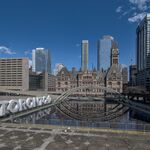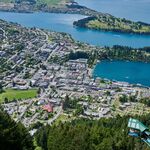Article
The error of our subways
While the rest of the world gets it right, Toronto is trapped in a transit wasteland
May 7, 2006. 01:00 AM
CHRISTOPHER HUME
TORONTO STAR
This is the final article in a three-part series by Christopher Hume on the issues that most stirred readers of the Sunday Star's What If? report on April 16. The other two issues were making the city more pedestrian-friendly, and making it more green.
This week Hume writes about readers' desire for a better transit system.
Some time during the last two decades, public transit in Toronto took a wrong turn. As a result, what was once "the better way" is now the lesser way.
But Sunday Star readers made it clear after the recent What If? package that they want the Toronto Transit Commission back on the rails.
Of course, the TTC isn't entirely to blame for its woes. The government of Ontario, starting with former Conservative premier Mike Harris and continuing under Premier Dalton McGuinty, has done most of the damage through devastating funding cuts. The TTC is now the only major transit operation on the planet that must make up the bulk of its funding through the ticket box.
Under chief general manager Rick Ducharme, the TTC has adopted a strictly nuts-and-bolts mentality that leaves the organization unable to see the big picture.
Any way you look at it, the commission, and Toronto transit users, are now paying the price for years of bad planning, deferred maintenance, and political interference.
More than anything, however, it is the politicization of transit that has caused untold resources to be wasted and opportunities missed.
The most egregious example is the line to nowhere — the Sheppard subway. It was the brainchild of former mayor Mel Lastman, who, with his fellow politicians, ignored all the best advice and carried on regardless, wasting $1 billion in the process.
Such is the price of vanity.
As respected Toronto transportation consultant Ed Levy points out, the subway should have been built west of Yonge — not east — to the Downsview Station. That way, he argues, we would have taken a giant step toward maximizing transit usage.
"Connections are key," Levy says. "The connection between Yonge and Downsview is the missing link. If we had built that, we'd have a genuine network. Building the subway east of Yonge was a bloody shame."
But even more than the "missing link," says Levy, we should have built a "pre-metro" on Eglinton Ave.; specifically, an advanced light-rail vehicle system, partially underground, partially above, that could be expanded into a full subway when necessary.
This should have been priority number one, he insists, not satisfying the vanity of our political masters.
Instead, Eglinton — the only road that travels through all the former municipalities forcibly amalgamated in 1998 — is a messy and inefficient patchwork of bus routes that leaves thousands of users ill served.
In Levy's plan, the Eglinton LRT would travel underground in a "shallow tunnel" from Leaside to Keele St.
Beyond that, it would be above ground at both ends, east and west. The stations would be modest and close to one another. The line, he explains, should extend all the way from Scarborough to north Etobicoke and Pearson Airport. It could be constructed at a fraction of the cost of a full-fledged metro.
`Toronto is one of very few cities with streetcars in mixed traffic. It's a killer'
Ed Levy
Transportation consultant
The station at Yonge and Eglinton would then become a major hub, the centre of a transportation grid that provides access in every direction.
Speaking of light-rail transit, Levy doesn't like what he sees here. He calls Toronto's streetcars "appalling."
Because the motor is below the floor, passengers must climb four steps to board the vehicle. By contrast, in state-of-the-art LRTs, mechanical equipment is on the roof, which means the floor is lower and more accessible. This is especially important for seniors and children, as well as people carrying a load.
These vehicles are also lighter, quieter and more energy-efficient. According to Levy, the proof that the Toronto streetcar is inadequate lies in the fact that, despite an aggressive marketing campaign, not a single vehicle has been manufactured and sold to another city.
As he also points out, "Toronto is one of very few cities with streetcars in mixed traffic. It's a killer."
Most frustrating, however, is that intelligent plans for a comprehensive transit system have been sitting on the shelf for nearly a century.
A report prepared for Toronto city council in 1910 proposed a subway network that would have started at Union Station then moved west to Spadina, north to College, west to Dovercourt, north to Bloor, and along Bloor to Dundas St. W. and St. Clair.
From there a streetcar line would extend east along St. Clair to Don Mills, then south to Danforth and Broadview, where the subway picks up again. Also included was a Yonge subway from Union Station to St. Clair.
One might quibble with the details — in 1910, Toronto was a town of 300,000 surrounded by farmers' fields — but even today, the scheme makes more sense than what got built.
The argument now is that we're too poor to build subways.
True, the line to York University has been launched, sort of, but is that the best use of $1.2 billion?
Given York's low-density campus and the wholly inappropriate suburban subdivision recently built at the south end of the university on land the university sold to Tribute Communities, the answer is no. Clearly, York hasn't progressed beyond its outdated, car-dependent mentality.
To be economically viable, subways need densities of between 10,000 and 15,000 people per square kilometre. In other words, an LRT line would be a better solution, especially given that the bulk of ridership will be during school hours.
Currently, York commuters must rely on buses, of which 1,700 travel daily through to the campus. But buses are more polluting and less appealing. As a form of urban transit, they are generally considered inferior to LRTs and subways.
"Land-use patterns outside the city will never encourage transit," Levy makes clear. "It's much too spread out. That's why public transit doesn't have a role to play outside the city. You need high density."
Levy points to cities such as Madrid, Barcelona, Bilbao, and Portland, Ore. Madrid has been especially aggressive in its subway building. Though it's roughly the same size as Toronto in terms of population, it continues to expand its metro, which now reaches to the outer rungs of the city.
Bilbao, which some compare to Hamilton, embarked on an ambitious rebuilding scheme in the 1980s that included public transit. In addition to a new LRT route that snakes its way through the city on a track bed planted with grass, the Spanish steel town commissioned celebrated U.K. architect Norman Foster to design a subway system.
"What they're doing blows your mind," says Levy. "They get money from all levels of government. But the secret is that all levels of government are in agreement. As a result, the systems, especially in Madrid, are tremendously well used.
"If they can do it, why can't we?"





